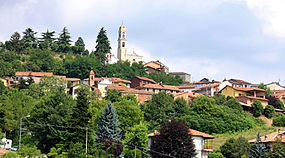Albugnano
| ||||
|---|---|---|---|---|
Comuna | ||||
 | ||||
 | ||||
 Albugnano Localização de Albugnano na Itália | ||||
| Coordenadas | ||||
Região | ||||
Província | Asti | |||
| Área | ||||
| - Total | 9 54 km² | |||
Altitude | 549 m | |||
População | ||||
| - Total | 520 (30-4-2 017) | |||
• Densidade | 54,51 hab./km² | |||
| Outros dados | ||||
| Comunas limítrofes | Aramengo, Berzano di San Pietro, Castelnuovo Don Bosco, Moncucco Torinese, Passerano Marmorito, Pino d'Asti | |||
| Código ISTAT | 5002 | |||
| Código cadastral | A173 | |||
Código postal | 14020 | |||
| Prefixo telefônico | 011 | |||
Padroeiro | | |||
| Website | www.comune.albugnano.at.it | |||
Albugnano é uma comuna italiana da região do Piemonte, província de Asti, com cerca de 462 habitantes. Estende-se por uma área de 9 km², tendo uma densidade populacional de 51 hab/km². Faz fronteira com Aramengo, Berzano di San Pietro, Castelnuovo Don Bosco, Moncucco Torinese, Passerano Marmorito, Pino d'Asti.[1][2][3]
Demografia |
| Variação demográfica do município entre 1861 e 2011[3] |
 |
| Fonte: Istituto Nazionale di Statistica (ISTAT) - Elaboração gráfica da Wikipedia |
Referências
↑ «Statistiche demografiche ISTAT» (em italiano). Dato istat
↑ «Popolazione residente al 31 dicembre 2010» (em italiano). Dato istat
↑ ab «Istituto Nazionale di Statistica» 🔗 (em italiano). Statistiche I.Stat